
Newsletter of the Shell Club of Sydney
NSW Branch, The Malacological Society of Australasia Limited ACN 067 894 848
Weedy Seadragons
Phyllopteryx taeniolatus (Lacépède, 1804)
Steve Dean
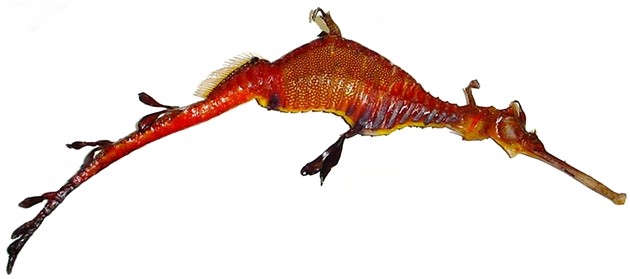
After rough seas dead Weedy
Seadragons wash in on the beaches where I live - Mona Vale and Warriewood (North of Narrabeen in
Sydney) Usually the ones I find have lost much of their colour and are
fairly dry and hard, although still with their fronds. Typically they
are at the high tide line along with dead leather jackets and various types of
box fish. Their dry state is explained because they are beached in the
sun at the high tide line and I arrive 6 hours later for the low tide. The one I found a week ago
at Mona Vale was still brightly coloured and
flexible, so I photographed it for this Sheller - the day was overcast
and cool. Afterwards all I had to preserve it
was Methylated Spirits, which unfortunately leached out all the colour
within an hour, so it now looks much like other beached specimens
I have collected. Weedy Seadragons are endemic to Australia in temperate
waters from Port Stephens, north of Sydney, to Geraldton in WA.. They are a protected species and grow to
46cm They belong to the Syngnathidae which includes Seahorses,
Pipehorses and Pipefishes. They are observable live by scuba divers in
many parts of Sydney as they live from 3m to 50m depth amongst the kelp
on submerged rocky outcrops. Like Seahorses the males carry the eggs,
however the male has no pouch so the eggs are just attached to the
underside of the tail. There is an organization that is
monitoring Seadragon sightings live and dead: 'Dragon Search'. Its goal
is to contribute to the conservation of Seadragons by enlisting the
public to submit their observations thus adding to the accumulated data
and increasing awareness. It has branches in all states where Seadragons
are found. Its web site even includes a code of conduct for divers
observing Seadragons. Using the public yields data that may be
considered less reliable as to date, locality, terrain or even correct
identification, however the data can certainly be used to show trends such as
unusually high death rates, and to better define the range and possible
habitats, and probably a lot of other uses as tabulated on their web
site. Dragon
Searches article in various publications does an excellent job of increasing public awareness
for the need to conserve Seadragons. Note, there is another endemic
Seadragon from Temperate Australia - the Leafy Seadragon, but we do not
see it as far north as Sydney.
Visit to Kangaroo Island February 2003.
May meeting presentation. 20th May 2003.
Michael Keats
Kangaroo Island has always been one of those places that we have on our list to visit but somehow never quite made it. This year a combination of circumstances put proposed overseas holidays on hold so we scouted around for something local which we had not been to before.
After eliminating all the options that required more than two weeks to do justice to, Kangaroo Island was it.
To make the trip as a whole more interesting we included the South Australian Wine country, covering the Maclaren Vale, the Barossa Valley and the Limestone Coast. To finish off we followed the coast all the way to Melbourne.
Kangaroo Island lies to the south of the Gulf of St Vincent, effectively enclosing it with the twin peninsulas of Yorke and Fleurieu. The body of water separating island from the mainland is the Investigator Strait.
We hired a car in Adelaide and after a leisurely two days tasting in the Maclaren Vale, headed south and boarded the vehicular ferry at Cape Jervis. Given the inevitable delay of unloading 60 plus vehicles and then reloading there was ample time to explore the coast for shells. Disappointing is the word that best sums up the position. The water of the Strait is cold and the 'roaring forties' pound the coast relentlessly.
My shell haul was dominated by the Trochid, Chlorodiloma adelaidae, Philippi, 1849, being 80% of all the shells seen. The small brown Trochid,
Clanculus ochroleucus, (Philippi, 1853) was scarce. One specimen of
Clanculus undata, Lamarck 1816 was found. A miscellaneous collection of Buccinids (too worn to have a certain ID) and two specimens of the Collumbellid,
Zemitrella lincolnensis, Reeve 1859 completed the gastropods.
The Mytilids, M. erosus, Lamarck 1819 and M. planulatus, Lamarck 1819 represented the bivalves.
An eventful 1 hour crossing with mountainous waves and the conspicuous use sea sickness bags by others found us in Penneshaw, the 'port' of Kangaroo Island feeling fragile but able to carry on with our program.
Unlike most visitors we did not head for our accommodation but took the road east to Cape Willoughby and Windmill Bay. Shelling was not even on the agenda. A description of Windmill Bay " The beach is covered with almost perfectly round rocks and pebbles; a look at the roaring surf as it crashes over the rocks will soon give you the clue to their formation." A great spot for scenery and perhaps shell grit fit for the chooks.
A bit about the Island. Up until Cainozoic time, some 2 million years ago, the island comprised two separate islands essentially of Cambrian rocks. The areas of greatest interest to tourists are sculpted from Ordovician Granites that occur as large 'plugs' in a somewhat random pattern, but often on the coast as at "The Remarkables".
The areas of the island of interest to shell collectors are almost exclusively based on Quaternary sands of varying ages. These sands not only linked the islands together but also provided the necessary safe havens for molluscs to establish and flourish in calm shallow waters.
To make life complicated for shell collectors more than half the island is gazetted as one of several National Parks or similar conservation areas.
Being with my wife Jenny meant that full time shelling was not an option. We did a lot of very rewarding sight seeing as well. I also managed some bush walking which provided an opportunity to look for land snails. More about that later.
We chose the small village of American River as our base. From here each morning I was able to visit the extensive tidal flats, some 100 metres from the motel door. American River is on the north coast, situated on the western edge of a shallow bay known as Eastern Cove.
Roughly rectangular in shape, the cove is approximately 6 kilometres wide and 8 kilometres long with its axis running from the NE to the SW. Including its southern extension, Pelican Lagoon, it nearly divides the island into two. The cove does not change water very frequently even though it is tidal. There is a great deal of dead and dying sea grass and other organic matter on the shore. It is one of the few low energy areas around the island. Other areas which are similar are the Bay of Shoals and Western Cove
Ancient sand dunes less than a kilometre wide culminating in Prospect Hill, show that process of the 'joining' of the two islands is still a work in progress. A climb to the top of Prospect Hill with a dune crest some 100 metres high, gives the viewer the sight of gentle shallow waters to the north and with a turn of the head, raging surf to the south.
The western shore of Eastern Cove is almost a solid shell mass. Indeed the beach has no sand as such; it is all shells! Most of the material is very small and I have brought a bag of it in
to todays meeting for those attending to look at. The material is not exciting and I was not equipped with the right gear to get out far enough at low tide to see whether there is a lot of good live material. The substrate is loose sand with occasional deep holes. Not a place to hang around on or in.
The finest collecting I did was on the western shore of D'Estrees Bay between the old whaling station and Point Tinline. The bay here has a gentle gradient, sandy bottom and is very shallow out into the Great Australian Bight for nearly a kilometre. It is not a low energy area as the selection of collected species will testify.
Along a section of beach of no more than 150 metres was a veritable treasure trove of variety. Quality was average. A visit here at the right time would yield great material. I kick myself now for not having gathered several kilograms of beach wash to bring back for washing and sorting.
The first is a terebrid, Duplicaria kieneri (Deshayes, 1859). Dead specimens of this species were reasonably common and in reasonable condition.
I found a specimen of the reasonably uncommon trochid, Clanculus ochroleucus
(Philippi, 1853). It is in reasonable condition and worthy of being added to the collection.
Perhaps the specimen that captured most of my attention was a Turrid. I have not yet been able to put a name on it.
D'Estrees Bay is noteworthy as the best place on the island to collect Paper Nautilus
(Argonauta nodosa) egg cases. We did a lot of looking but were out gunned by the locals who know when to come down and what to look for. Interestingly the very fragile egg case is very pliable when it is in use by the animal and can be kept that way by keeping it wet.
All other beaches visited had few shells and even fewer places that cried out for exploration.
My bushwalking effort was at the far western edge of the Island near Cape Borda. Here in the Flinders National Park is some of the best topography on the island. It is also unusual as it is a limestone area. It goes by the name of the Ravine de Casoars. Here one would expect to find lots of native snails however the infestation of
Helicella virgata and Cochlicella acuta have driven out most of the indigenous snail population. I found one dead snail shell under a rotting log. I would punt on it being a Camaenid species of some kind. It is available for ID.
The development of Marron (Cherax tenuimanus) and Yabbie (Cherax
destructor) farming has become a major export industry. Visitors to the farms are encouraged to try Cherax take-away meals or eat in house. Not too different to crayfish in flavour and just as difficult to get at all the meat!
The Island also now sports a growing wine industry with 8 vineyards and the locals claiming to be the next great wine region of Australia! Having sampled a few we are not quite so sure.
Answers to the quiz from the
March/April Issue John
Franklin If you have any favourite topics you think we should cover please let us have the details in question and answer
form for future shellers.
Q1 Palaeozoic Period, about 500,000,000 years ago
Q2(a) If they live, fixed or mobile on the substratum (benthic).
Q2(b) If they move freely in the water (pelagic).
Q3 Melluscan distribution in our seas and oceans. He drew maps showing 17 zoogeographical provinces.
Q4 The procedure to categorise animals is called nomenclature and this procedure is governed by a set of rules drawn up by the
I.C.Z.N.
Q5 Our marine heritage, apart from bad and illegal collecting methods, can also be affected by:
the disposal of waste waters
pollution due to ecological imbalances
thermal pollution
chemical pollution
nuclear pollution
visual pollution
Q6 The Latin terminations which apply to each systematical group of species are:
'acea' for super family, e.g. Mytilacea
'idae' for family, e.g. Mytilidae
'inae' for sub-family, e.g. Mytilinae
A new quiz - Guess the Cowries
Ashley Miskelly
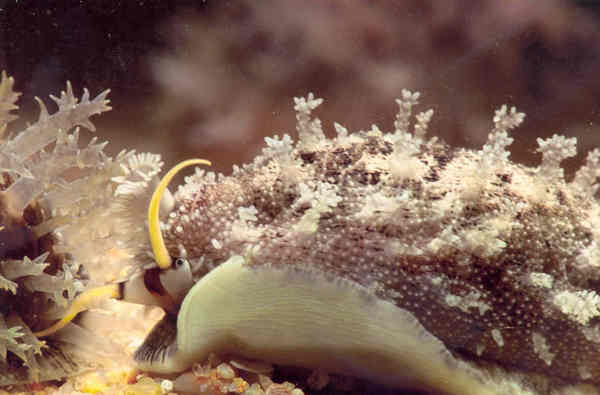
Cypraea 1
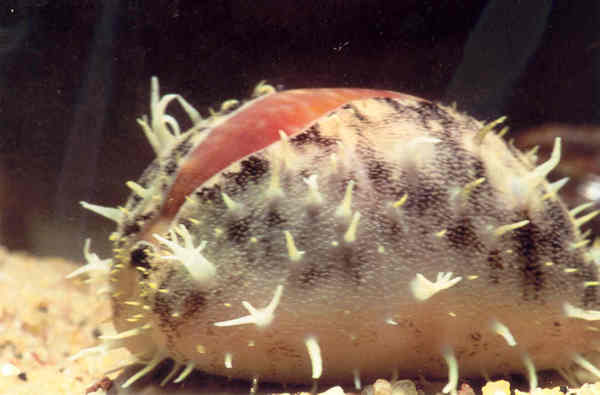
Cypraea 2
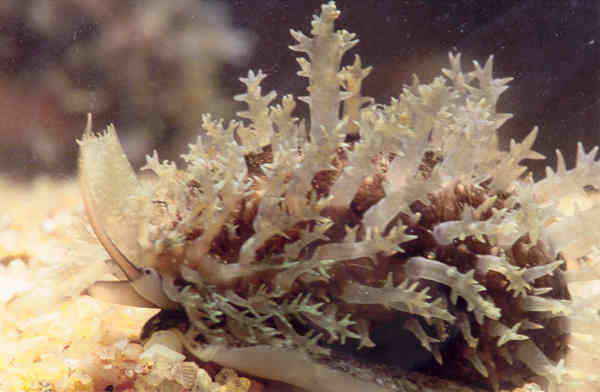
Cypraea 3
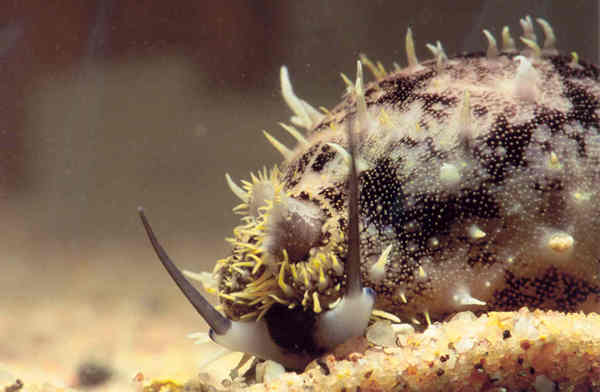
Cypraea 4
The pictures show four live cowries, can you guess
what species they are?
Shell Club Minutes 26/04/2003.
The meeting was opened by P Jansen at 2.04 pm.
Field Trips
The field trip proposed for the 17th April 2003 was postponed due to bad weather.
J. Franklin reported on a trip to South Durras, P. Pienaar added that North Durras was also good for shelling.
J. Dunkerley reported on a trip to Bundaberg. John stated that the snorkelling was very good and the common cowries such as
Cypraea caputserpentis Linnaeus, 1758 and C. errones Linnaeus, 1758 were plentiful.
R. Moylan reported on a trip to the Capricorn Bunker Group off Qld. Ron reported collecting some melanistic Cypraeidae; these included
C. felina Gmelin, 1791, C. lynx Linnaeus, 1758,
C. caurica Linnaeus, 1758, C. vitellus Linnaeus 1758 and a specimen of C. punctata Linnaeus 1771, which is apparently quite uncommon in Australian waters. Ron also collected
Cymbiola pulchra forma woolacottae ( McMichael, 1958 ).
C. Barnes reported on a visit to Long Bay and Little Bay where he found a live specimen of
Cerithium columna Sowerby, 1834 and a very nice specimen of
Conus anemone Lamarck, 1810.
M. Keats reported on a Meridolum sp, found whilst bush walking in the state forest, the specimen was approximately 2cm in diameter and will be handed on to S. Clark.
General Business
J. Franklin reported that RELC has once again donated a free dinner to the value of $90.00 to the club.
S. Dean demonstrated the club web site to the meeting, www.sydneyshellclub.net
and also discussed the club library and possible future purchases. It was agreed to have further discussion at the next meeting.
Steve also discussed adding information from back copies of the "Sheller" to the web site and requested help from anyone who could assist with the following issues:
December 1980, February 1981 Vol 3 issue 2, December 1982, December 1983, March 1984, April 1984, May 1989, June 1989, August 1989, November 1989, March 1991, January 1998. It is probably safe to assume the three December ones and many of the others were probably never printed. However if anyone has any of the above issues we are in
desperate need of a copy.
Letter, possible new member Dr Nestor Figol,
Letter, Migon Naraynat from Thailand, wishes to exchange specimens with interested parties.
Presentation
Des Beechey gave a practical demonstration of his web site "The Seashells of New South Wales". The set up and layout of the site is as a book, with text leading into the family background, literature references and coverage of species in NSW, then plates. The site
currently covers about 1/3 of NSW gastropods and is a work in progress with Des still adding families as time and space allow (the site has a 10meg limit). Des responded to the many questions from members; all present appeared to enjoyed the presentation and discussion.
Mollusc Issues - Chinamen's Beach
By Michael Keats
Notes on Mollusc issues relating to Chinamen's Beach for discussion at a Marine Biodiversity Seminar
held 14/05/2003 at the Mosman Art Gallery and Community Centre
(Note over 80 people attended)
Chinamen's Beach is one of the richest marine mollusc biodiversity areas in the Sydney area. A list of collected species over an 18 month period in 1996-1997 showed more than 188 Gastropods, 61 Bivalves, 5 Echinoids, 3 Cephalopods, 1 Scaphopod and 1 Brachiopod.
Geographically Chinamen's Beach is privileged in that it has both estuarine as well as ocean influences. The marine substrates include sand, residual sea grass beds and rock platforms. The intertidal area is relatively large in relation to tidal movements and deep water is near by. There is also a natural water-course that provides opportunity for brackish water species to survive. Residual dune grasses also provide for terrestrial molluscs to exist.
Why should we be concerned? The simple answer is that pressures on the mollusc fauna are such that unless some initiatives are taken to reduce those that are reversible, Chinamen's Beach will become initially a sterile white stretch of sand with green moss covered rocks. This will be succeeded by progressive sand discoloration and slime build up. It may take 20 years but it will end up like so many once pleasant beaches elsewhere in the Harbour. There is already evidence of the beach grit 'ageing' i.e. it is not being replenished from current populations.
What is at risk? The simple answer is we do not know enough to be sure. We do know that in relative terms for the rest of Sydney Harbour Chinamen's Beach still does have a very diverse mollusc fauna. Like the rest of the harbour the mollusc fauna is at risk. Although not documented species most sensitive to environment change are likely to be the first casualties. This list would have to include all sessile molluscs, filter feeders and those dependent on restricted salinity and temperature range movements
There is a need for a detailed longitudinal study and audit to be conducted of what mollusc species are still extant in the area. There is a need to understand the complex interrelationship between natural physical factors (currents, water temperature, micro environments etc) and the impact of human activity
Because of the complexity of impacting factors any study must be a longitudinal one spanning at least five years. It needs to include consideration of macro factors such as ocean currents, El Nino, La Nina and more. Local circumstances also impact on the "apparent supply" and survival of veliger stages of molluscs. Species which appear 'rare' during one season may be plentiful the next.
Sampling the beach drift (the least destructive approach) is a different 'experience' every tide. 1997 was a particularly good year for mollusc species both in diversity and quantity. The years since to 2001 have not. I have not visited Chinamen's Beach in the last 2 years. The Chinamen's Beach experience from 1996 to 2001 is consistent for sampling at Washaway Beach (to the east on the eastern face of Grotto Point) and Cobbler's Beach (to the south east on the north face of Middle Head).
Factors impacting on the mollusc fauna
Climatic Factors
Current beach grit studies being undertaken at Long Bay (Malabar Beach, Randwick Council) have shown the last 2 years to be exceptional in the number of so called Tropical Species regularly occurring in Sydney Waters. Comparison with documented materials in the Australian Museum Collection show a significant extension of the Southern limits of many species. In January this year 3 specimens were collected at the site of a species normally endemic to Hawaii!
A colleague working in at Long Bay has documented more than 30 gastropod species that appear to have new southern extensions. A particular species
Gyrineum lacunatum, has now been recorded as far south as Jervis Bay.
The reasons for these exceptional findings are not well understood. It could be that past samplings have not been thorough and therefore the ranges have not been accurately recorded in the past. 200 years of recording (and specimen lodgement in the Australian Museum) are however unlikely to have missed such finds. It is more likely however that increased water temperatures generally and milder winter minimum water temperatures have allowed veliger of many species carried on the currents to survive the southern journey and grow into mature adults
We do not know whether these circumstances are temporary or whether they represent the start of a significant long- term trend. We also do not know what effects these new arrivals may have on existing populations. As Long Bay is south of Chinamen's Beach it can be assumed with reasonable confidence that current grit sampling at Chinamen's Beach would identify the presence of 'aberrant' species. The protracted dry period in the second half of 2002 has meant that the usual influx of fresh water near the shore has not occurred and therefore salinity levels have been higher than normal. This is only one of what could be many significant factors
Pollution factors. Pollution includes sewage, storm water (local runoff and upstream sources as well), flotsam and jetsam and garbage from visitors (whether from vessels or beach visitors). A lot of pollution can be minimised.
Run off. The relatively steep scarp, the increasing percentage of the land surface in the catchment area covered by hard non- absorbent materials is a concern. This increases both the volume and velocity of run off water. The impact on existing bottom sediment by consequent turbulence, suspended particles and salinity has negative impacts on bottom dwelling species. Nutrients, vehicle oils, chemical residues and dissolved oxygen levels are all changed by runoff. This is a toxic mix for many mollusc species. Whilst there is some recolonisation from other areas, most of the affected areas in the Harbour are under similar pressure.
Beach grooming. Beach grooming is an unfortunate reality of many beaches in populated areas where the residents want the beach to look perfect all the time. It is not nature's way and in the long term it has a negative effect. Among the significant factors is an unintended removal of Calcium Carbonate (CaCO3) in the form of shells and consequent loss of calcium for new molluscs to secrete shells as well as providing habitat for other sea creatures. Is a particular problem for the Chinamen's Beach hermit crab population. This population has declined significantly over the last 20 years.
The decaying kelp and other sea weeds provide habitat for indigenous beach midges and flies; in turn these provide food sources for a variety of marine and avian species
Boating activities. Every anchor drop disturbs the sea bottom. Local sea grass beds are almost now totally destroyed. Again there is habit loss and consequent species loss
Other issues
Commercial fishing. This is of increasing impact particularly for the species directly affected such as the octopods and squids. Given the shallow waters off Chinamen's Beach a number of bottom dwelling species are also caught up as by catch. Even if returned by-catch rarely survives. Ideally commercial fishing should be banned.
Amateur fishing. Negligible impact
Food harvesting of the rock platforms. Not observed in the area
Beach shell collecting by children and families. Negligible although observed on many occasions
Possible actions for consideration
- Sydney Water accelerate the sewer line upgrade/replacement program and maintain a constant monitoring of line failures and take immediate corrective action
- Council to accelerate the requirement of building retention ponds for all properties to reduce the velocity of runoff
- Council controlled storm water lines to have retention ponds built and maintained in serviceable condition.
- Cooperation to be sought from local councils in the upstream catchment areas to implement
complementary programs
- After beach grooming have the contractor/operator remove plastics and metals and return all of the material to deep water off the beach and adjoining ocean area. This would reduce the depletion of calcium carbonate from the area and allow the hermit crab population to re establish. It would also return other marine nutrients to the ocean where they belong
- Discourage and /or regulate vessels from anchoring closer than 200m from the shore
Recommendations
That the Council
- commission a longitudinal study of the mollusc fauna of the beaches in the Municipality and seek the active participation of other Harbourside Councils in such a study.
- accelerate the installation of retention ponds for all properties
- accelerate the construction of retention ponds on storm water lines
- seek the cooperation of Sydney Water to reduce the escape of sewage into the storm water lines and establish a monitoring program
- hold discussions with the beach grooming contractor to return 'collected' material to the marine environment
- initiate discussions with Water Ways to restrict and or control anchoring craft in the immediate beach area
- discuss with NSW Fisheries the banning of commercial fishing in the area
- continue to work with other Councils and entities to preserve the mollusc population of all Harbour Beaches, particularly Chinamen's Beach
Selected Reference Materials
Estuarine Habit Management Guidelines - NSW Fisheries, J.J. Burchmore, D.A. Pollard,
M.J. Middleton and R.J. Williams (1993)
Sydney Coastal Councils Group and Protecting Wetlands Steering Committee Model DCP and Resource Folder (April 2001)
Sydney Regional Coastal Management Strategy - Sydney Coastal Council (1998)
Draft Policy for Commonwealth Responsibilities in the Coastal Zone (December 1992)
Protection of Marine and Estuarine Areas - a Challenge for Australians - NPWS Fourth Fenner Conference (October 1991)
Message in a Bottle
Have you ever found a message in a bottle while beachcombing for shells?
By Dan Parker.
I a writer living in Port Aransas, Tx. USA. I stumbled across the Sydney Shell Collectors Club Inc web site recently when I was doing research for a book I'm writing. I was wondering if you could help me with something.
The book I'm writing is to be a collection of true stories about people finding messages in bottles on seashores all over the world. I've found a lot of interesting such stories out
there. I am now is wrapping up my research but still would like to find a few
more message-in-bottle finders out there, to round out the book.
I've found that avid shellers and other beachcombers tend to find messages in bottles occasionally, and I'm wondering if anyone you know -- maybe a sheller, maybe not -- has found any and would be willing to share the story of their discovery with me.
In case you're wondering about my background, I'm 41 years old and have worked as a daily newspaper reporter for 18 years. Most recently, I worked for the Corpus Christi (Tx.) Caller-Times. I quit that job in January to become a full-time stay-at-home dad and to write this book.
In the past five years, I have found more than 100 people around the world who have found messages in
bottles, and in some cases, they've had some amazing stories to tell.
In some instances, messages floated at sea for years and travelled thousands of
Km before being found. Bottle launchers and finders sometimes have formed
close friendships that have lasted for years.
Stories have ranged the joyful to the dark and bizarre. In one case, a boy
launched a message in a bottle in the Arkansas River in the U.S. during the
1940s, and it found its way to a couple who lived in a swamp several hundred
miles away. The friendship that sprouted between the boy and the couple prompted
the boy to move near the couple when he grew up and adopt their lifestyle of
hunting and fishing. In another case, a man on the northeast coast of the U.S.
in 1975 found a bottle purportedly launched in 1943 with a message written in
German and a map that claimed the launcher was part of the crew of a German
U-boat that was sinking off the European coast. The bottle also contained two
1940s-era German coins and a bullet.
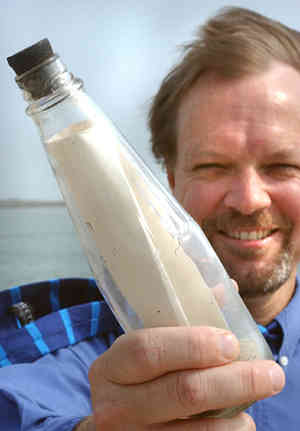
A resident of Oregon USA gave Parker the pictured bottle after finding
it on a beach in that state. The message was from an Oregon school child
researching ocean currents for a school project.
Thanks very much for entertaining my rather odd question.
Dan Parker, P.O. Box 235, Port Aransas, Tx. 78373, USA, cen60999@centurytel.net
Turbinellidae Part 22
Ulrich Knodel
The fourth and last sub family, the so called Pagoda
Shells, has a turbulent past. The group around "Columbarium" was seen first in Turridae, later as one genus in Muricidae, then split into further genera and sub genera as well as a family
(i.e. "Columbariidae") in the old superfamily "Muricacea" and later as a family in the old "Buccinacea". As the older superfamilies (i.e: Buccinacea, Volutacea et al) were reduced to only families within the large superfamily Muricoidea (Ponder, 1973), the "Pagoda Shells" were seen as a close to the Buccinidae. Further studies created the actual placement: as a subfamily of the Turbinellidae.
Columbariinae
The old genera and first known species were published between 1881 and 1927 (v. Martens,
Grabay, Finley.); the second evaluation of this group was in 1969 (Darragh) and in 1971 (Bayer). It was Harasewych (1983) who placed this group as a subfamily in
Turbinellidae:
"Comparison of the morphology of..(them) .. with that of certain Turbinellids
reveals close correspondence in such features as: presence of long, folded proboscis and non- evertable proboscis sheath; similarity in radular morphology; lack of accessory salivary glands; presence of an anal gland and open or partially fused sperm groove; diet of turbiculous polychaetes. These and other similarities leave little doubt that the group merits no more than subfamily status within the Turbinellidae". (cit. end)
A collection of this group is not easy to get. Within the rather few (sub-) genera approximately 180 species were published thus far of which roughly half are only known from fossils. Deep water dredging brings more and more species to our knowledge but often only the type material exist which is usually stored in scientific collections and museums. It is therefore hard for a private collector to get the known species "complete". This is one reason for the high commercial prices for this group; others include the breakable anterior canal which is often very long, thin and fragile and the deep water habitat combine to make perfect specimens high priced rarities. Nevertheless, they are worth their price; some species are real beauties. The photo below is a selection from my collection as an example of such beauties.
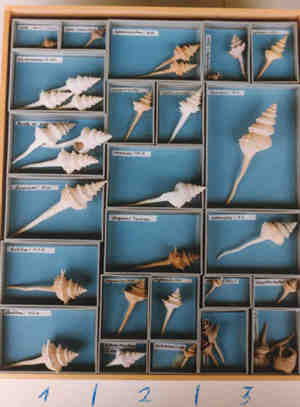
The shell is rather thin and fusiform, with a slender, fragile anterior canal, which in most species, is as long as or longer than the body whorl. Some have strong knobs at the periphery of each whorl but most species develop (often long) spines which may be straight or bent up or down. The spines may be few or many; spiral cords may be present often developed as rows of spiral knobs or short spines. The shells usually range in size from 30 to 80 mm although some species get to 150 mm. A chitinous operculum is present. The photo below displays a variety of shapes.
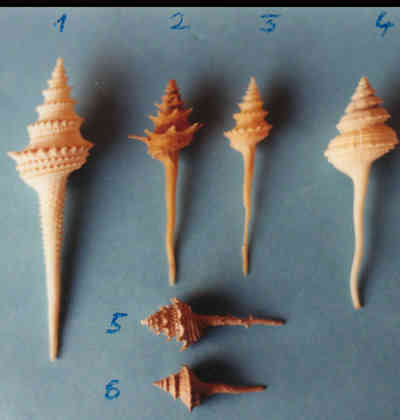
1. C. harrisae Harasewych, 1983 (trawled off Qld, 120 fathoms)
2. C. pagoda (Lesson 1834) off Japan, 30 m
3. C. spinicinctum (v.Martens 1881) 90m off S. Qld
4. C. wormaldi (Powell 1971) off northern NZ in 150m
5. C. cf. acanthostephes (fossil, Victoria, Australia)
6. Serratifusus cf. craspedolus (fossil, Victoria)
The systematical arrangement, is in parts, still doubtful. The list below follows Bayer (1971); modified by me ( fide Harasewych 1983 & 1986) and enlarged ( fide Darragh 1969).
Turbinellidae
Columbariinae Tomlin 1928
Columbarium von Martens 1881
Coluzea Allan 1926 (= Finlay 1927)
Fulgurofusus Grabau 1904
(Histricosceptrum) Darragh 1969
(Peristarium) Bayer 1971
Hispidofusus Darragh 1969 (fossil only)
Serratifusus Darragh 1969 (fossil only)
Remarks
Coluzea was reduced to subgenus status by Haarasewych (1983) and re raised to genus level by him (1986).
Fulgurofusus was reduced to a subgenus of Columbarium by Bayer (1971) and raised to genus level by Harasewych.
Histricosceptrum was published by Darragh with genus level but reduced to a subgenus of Columbarium (sic!) by Bayer (1971). Harasewych accepted the level of a subgenus (1983) but of Fulgurofusus (sic).
Peristarium was originally published as subgenus Bayer (1971) of Columbarium but seen by Harasewych (1983) as a subgenus of
Fulgurofusus.
Selected literature
Barnard, KH,
1959 Contributions to the knowledge of South African marine mollusca.. Ann. S. Afr. Mus. 45(1): 234 - 237.
Bayer, FM
1971 New and unusual molluscs trop. Western Atlantic. Bull. Mar. Sci. 21 (1): 169-183.
Clench, WJ
1944 The Genus Columbarium in the western Atlantic. Johnsonia 1 (15): 1-4
1959 The Genus Columbarium in the western Atlantic. Johnsonia 3 (39): 330-331
Clench, J and Aguayo CJ,
1938 Notes and descriptions new species..off Cuba. Mem. Coc. Cub. Hist. Nat. 125) : 382-385
1939 Notes and descriptions new deep water mollusc off Cuba. Mem Coc. Cub. Hist. Nat. 14 (1) : 86-87
Darragh, TA.
1969 A revision of the family Columbariidae (Moll: Gastr.). Proc. Roy. Soc. Vic. 83 (1) : 63-119
Harasewych, MG
1983 A new species of Columbarium.. from off eastern Australia. Nautilus 97 (1): 28 - 29
1983 A review of the Columbariinae (Gastropoda: Turbinellidae) of the western Atlantic with notes relationships subfamily.
Nemouria 27: 1 - 42
1986 The Columbariinae of the eastern Indian Ocean. J. Malac.Soc.Aust. 7 (3-4): 155-170
1989 A new species off Coluzea from off Southeastern Africa. Nautilus 103 (2): 70-72
Kilburn, RN
1970 On some species of the families.South African waters. Ann. Natal Mus. 20 (3): 489-491
1972 Notes on some benthic mollusca from Natal and Mozambique. Ann. Natal Mus. 21 (3): 568-571
Info:
Just some rare species are well figured in "American Seashells" and in Compendium of Seashells" (both by RT Abbott) but as in every older literature up to 1983 always within the
"Muricacea".
|








